March 31st 2023, Santiago Matatlán.
I suspect that Emelio Mato was catching 40 winks somewhere out back when I called into his roadside mazcal distillery on the edge of Santiago Matatlán. The distillery, a fairly ramshackle affair, was set back from the road by about 50 meters of sand, gravel, and was inside a long, open-sided lean-to shed. Initially, I rode past it and then a little further on, said to myself, this was your chance — you’ve passed so many and failed to take the opportunity; take this one.
And so I turned around, and rode across the gravel forecourt (if that’s not too grand a notion for the dusty wasteland, behind which the distillery was set), stopped, dismounted and turned off the engine. It was clear there was no one about and so I began poking around, taking a few shots, expecting someone to appear any second.
I had wanted to have a good look at a mezcal operation for about the last perhaps 50 kilometers. Mezcal, or mescal, is sort of Mexican hooch. In fairness, it’s a bit more than that and is now marketed slickly and backed by brand names, and classy displays in upmarket shops. Nonetheless, most of what I saw was definitely at the hooch end of the market. I rode Mexico 190, the federal highway that slices through the mountains south-east of Oaxaca, which is pronounced Woh-hacka and has had me befuddled for days! It is the capital of the Mexican state of the same name and its main income comes from tourism. It’s a great place — but more of that later. I was riding through the mountains, through intense heat, which makes stopped unattractive because instantly, one is drowning in sweat.
Anyhow, the landscape was really arid — the mountainsides were covered in dead grasses and shrubs, and trees, stunted by the conditions and apparently unable to grow more than 10 meters at most. Fires were commonplace, as evidenced by actual fires seen but also great swathes of the landscape blackened and struggling to recover from something that happened maybe last year. But every now and then, there would be a clearing and, planted in neat parallel rows, were spikey plants, a little bit like aloe vera plants that will be familiar to visitors to the Canaries. But these ones were, as I now know, agave or magueye plants, and I guessed they were somehow connected to the making of mezcal, though I assumed, wrongly, that it was the long, pointy dagger-like leaves that were used to make the drink.
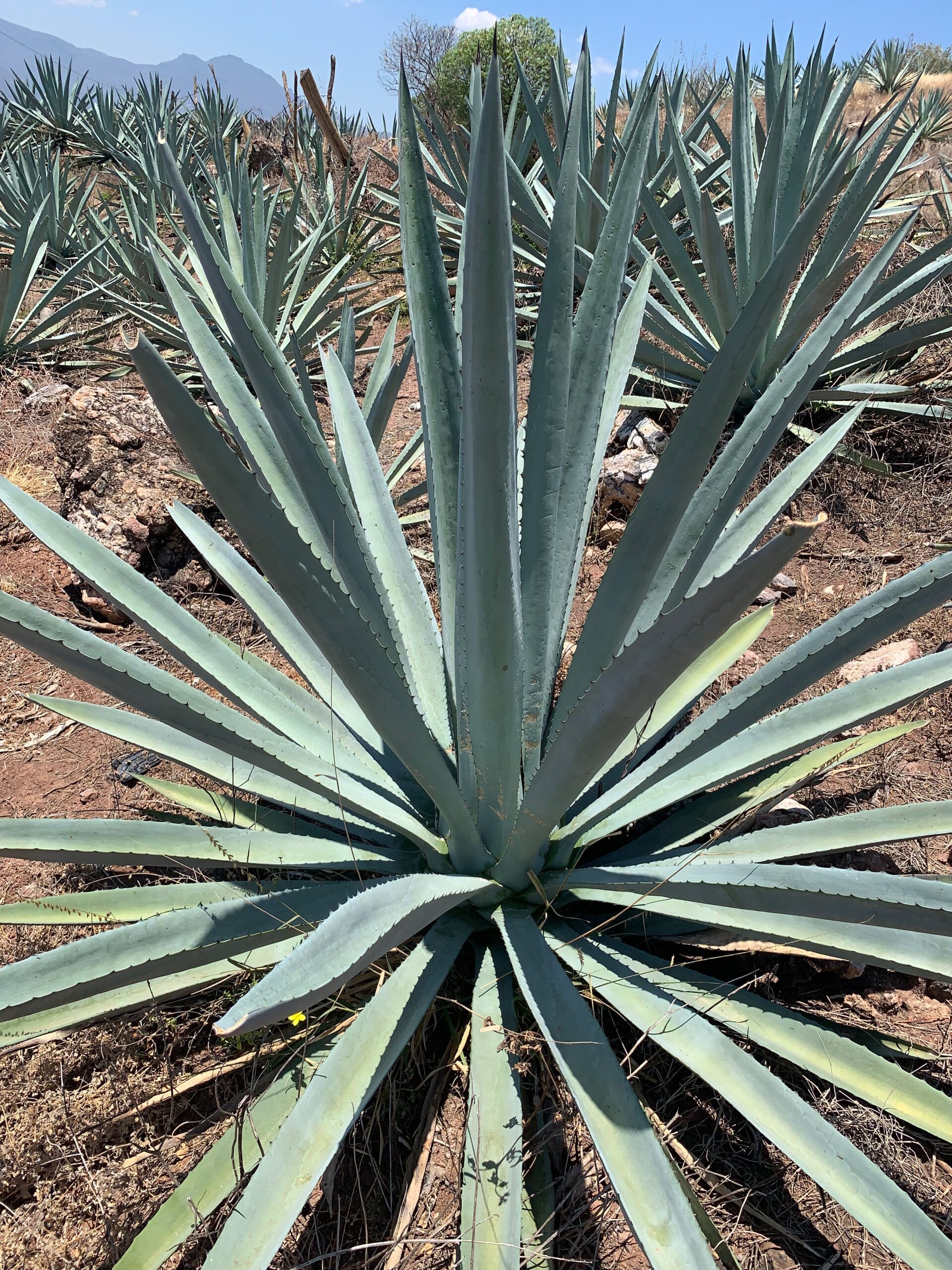
I passed my first roadside artisan distillery and was too late in making a decision to stop, assuming there’s be another soon enough. There were but none that looked attractive or particularly active and so I ploughed on, until noticing Emelio’s operation.
“Hola, hola!”, I shouted as I poked my way around and soon enough, there was the sound of movement out back and eventually Emelio emerged, slightly bleary-eyed. I said who I was and what I was interested in and would he mind if I had a look around. Boy, would he mind! No, no, no was the quick answer; away with you! Fine, I indicated, and apologised, making to leave. All of this was in Spanish. And just then, in good English, he said “You pay me? What you pay me?” I said yes, of course I’ll pay; I had no problem with that and fished a 100 peso note from my wallet — about €5. Emelio’s eyes lit up, he took the money and said: “Come, come’ you have camera?”
And with that, he took me over to the pile of what I would call agave hearts — the core of the plant, after the leaves had been sliced off to reveal something a little like a pineapple, through perhaps 10 times the size. This, Emelio explained was the start of making mazcal.
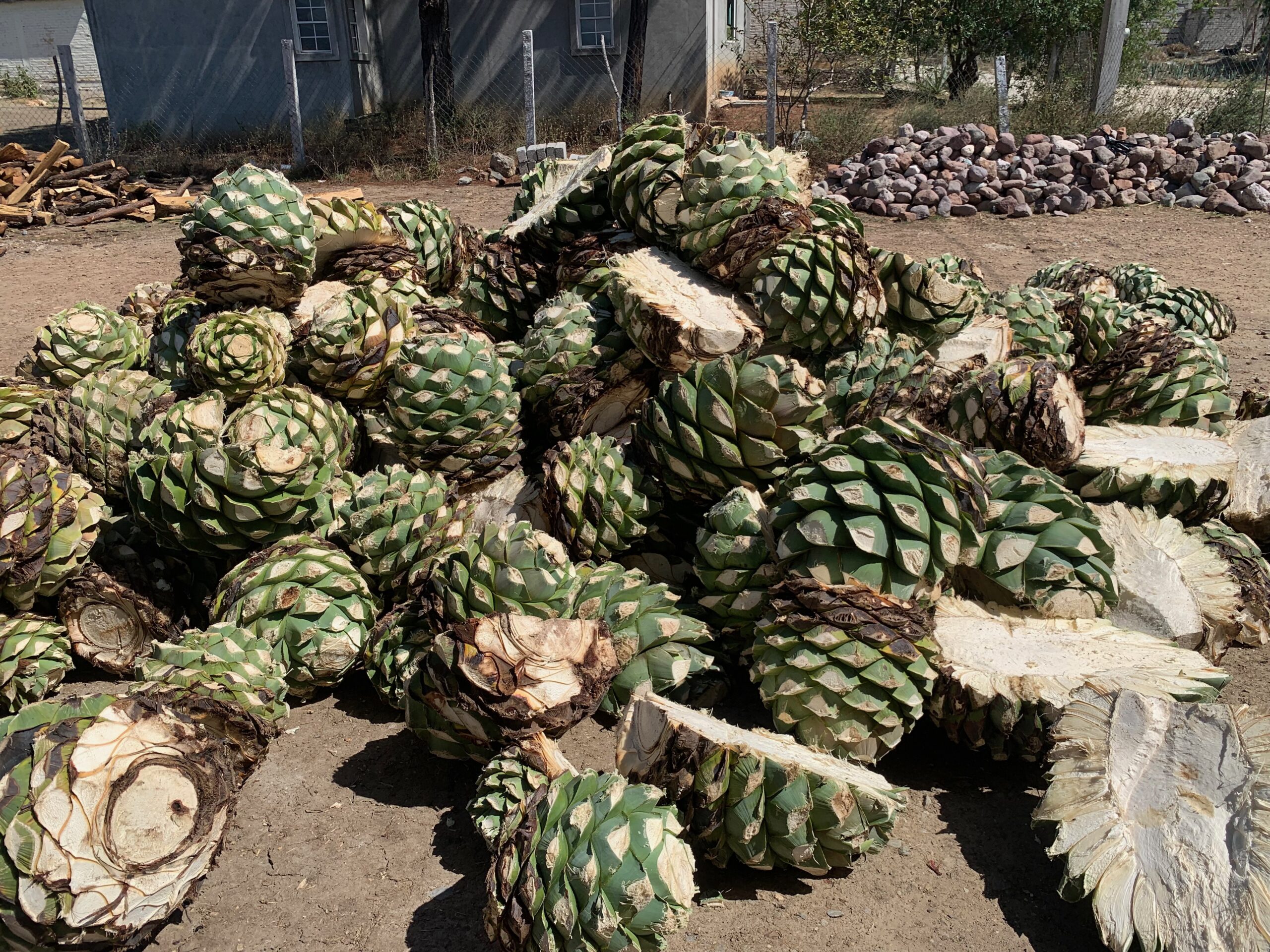
“You drink mezcal?” he asked.
“Not yet,” I said, and he smiled. I think he was warming to me.
The agave hearts had been sliced into twos and threes. Next to them was a large circular fire pit — perhaps two or three meters across. In it, were logs carefully arranged so that they rested to form a small dome. Emelio explained that on Monday, he would set the logs on fire and they would burn for four days. On top of them would be placed the split agave hearts and then everything would be covered with stones. Essentially, the hearts would be slow roasted and the wood turn to charcoal, as I could see from the debris of a recent fire.
How long the fire, I asked. “Quatros dias,” said Emelio. And then?
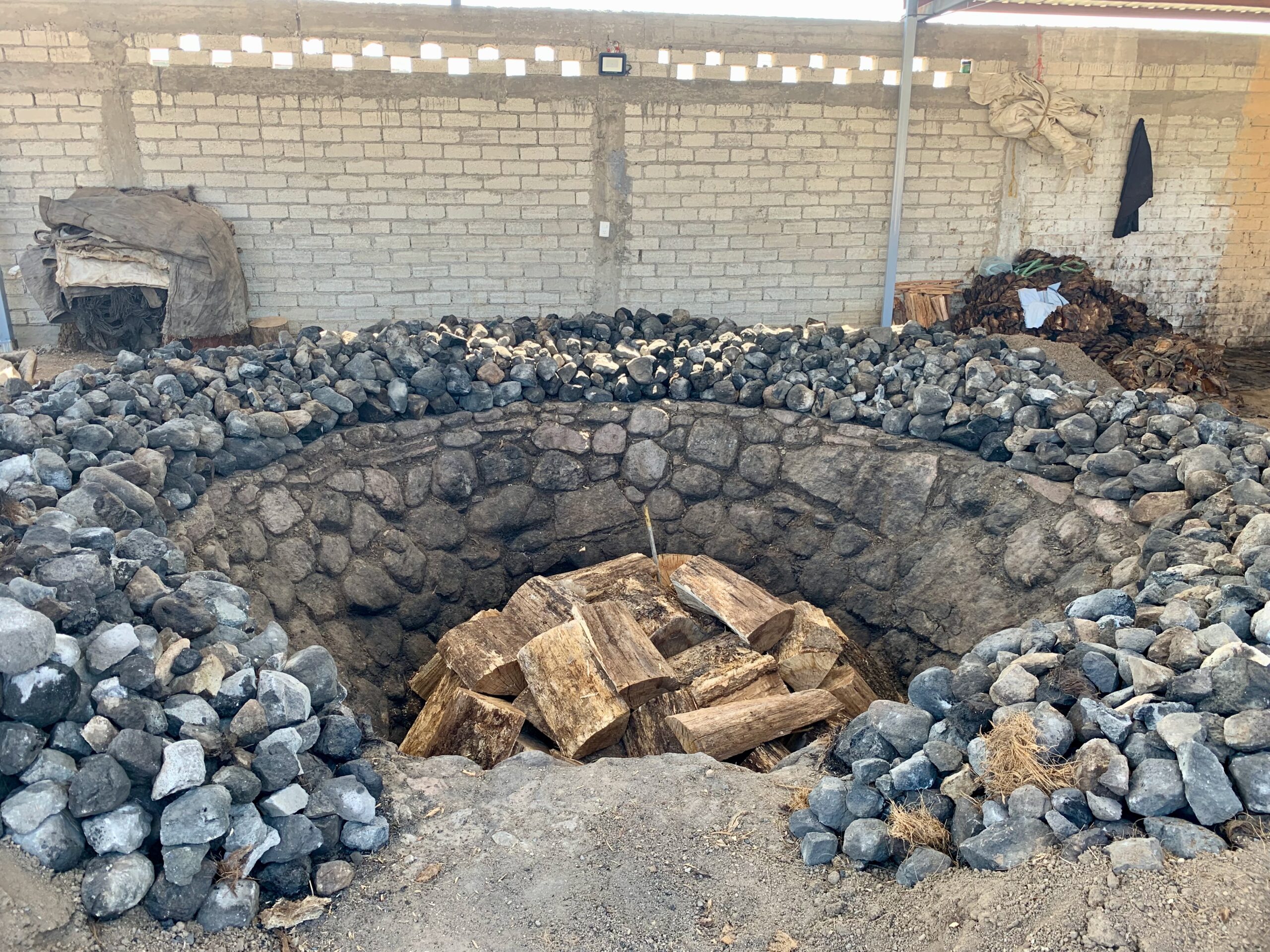
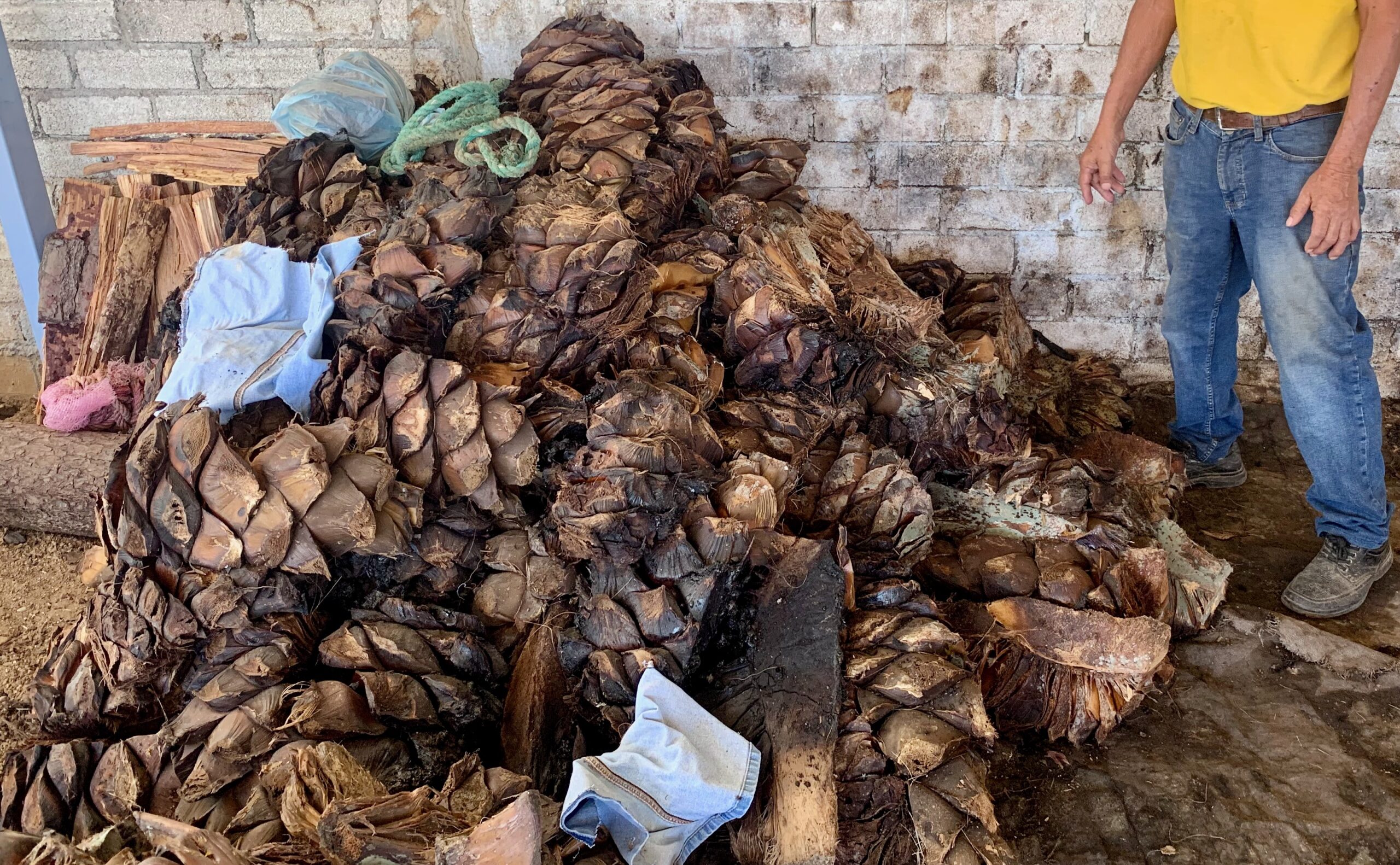
He ushered me to what looked like a pile of browned and rotting agave hearts, some so much so that, sitting there for a week, they had blue mound on them. He picked up a machete and went at one of them, slicing off bits about the size of orange quarters. He threw them into the next stage of the process — an ancient-looking stone roller mill. A large, circular stone wheel, maybe a meter and a half across was set on an axle, and, when pulled, went around the inside of a circular stone basin. There was a hole in the center of the basin, down which the liquid went to a tank underneath. The puller of the wheel, a well-used donkey was in a small shed across the lot, munching away and happy, one imagines, for the break from pulling the wheel.
The end result, apart from the liquid, is a mass of sort-of pulped agave hearts, though they now look like matted hair more than anything else.
The whole lot — liquid and pulped hearts — is decanted into large 300 liter wooden vats, about a meter tall and two meters across. The process starts at 2 or 3am (exactly why, I am not sure) and involves 150 liters of juice and 100 kilos of agave mush. I guess the shortfall leaves room to expand with fermentation. Emelio has three vats on the go, each quietly fermenting away. Dip your finger in and taste, he urged. I did. The first one — that is the newest fermentation — was quite a little bit sweet; the next one much more so; but the third was a little bitter and definitely tended towards something alcoholic.
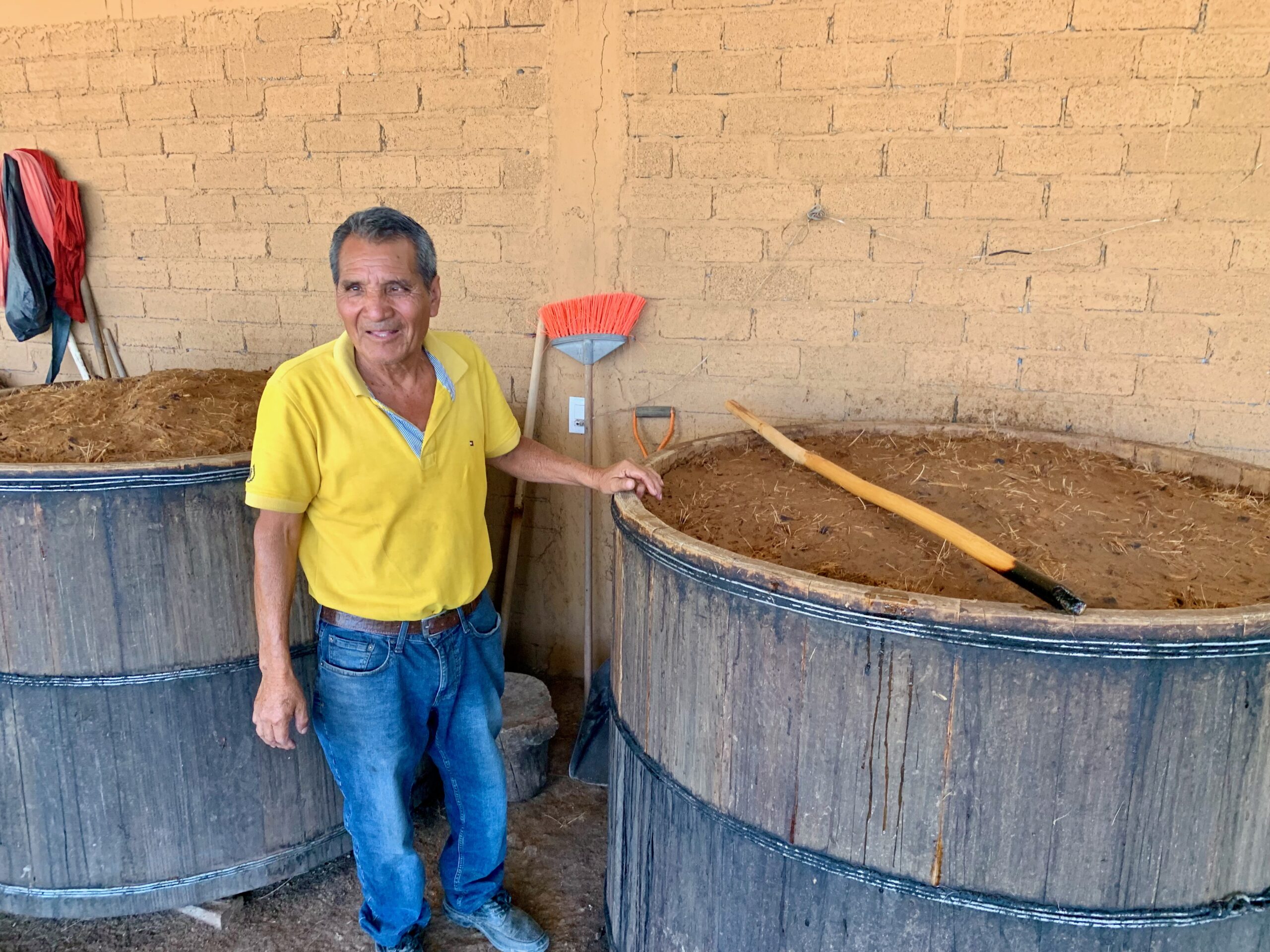
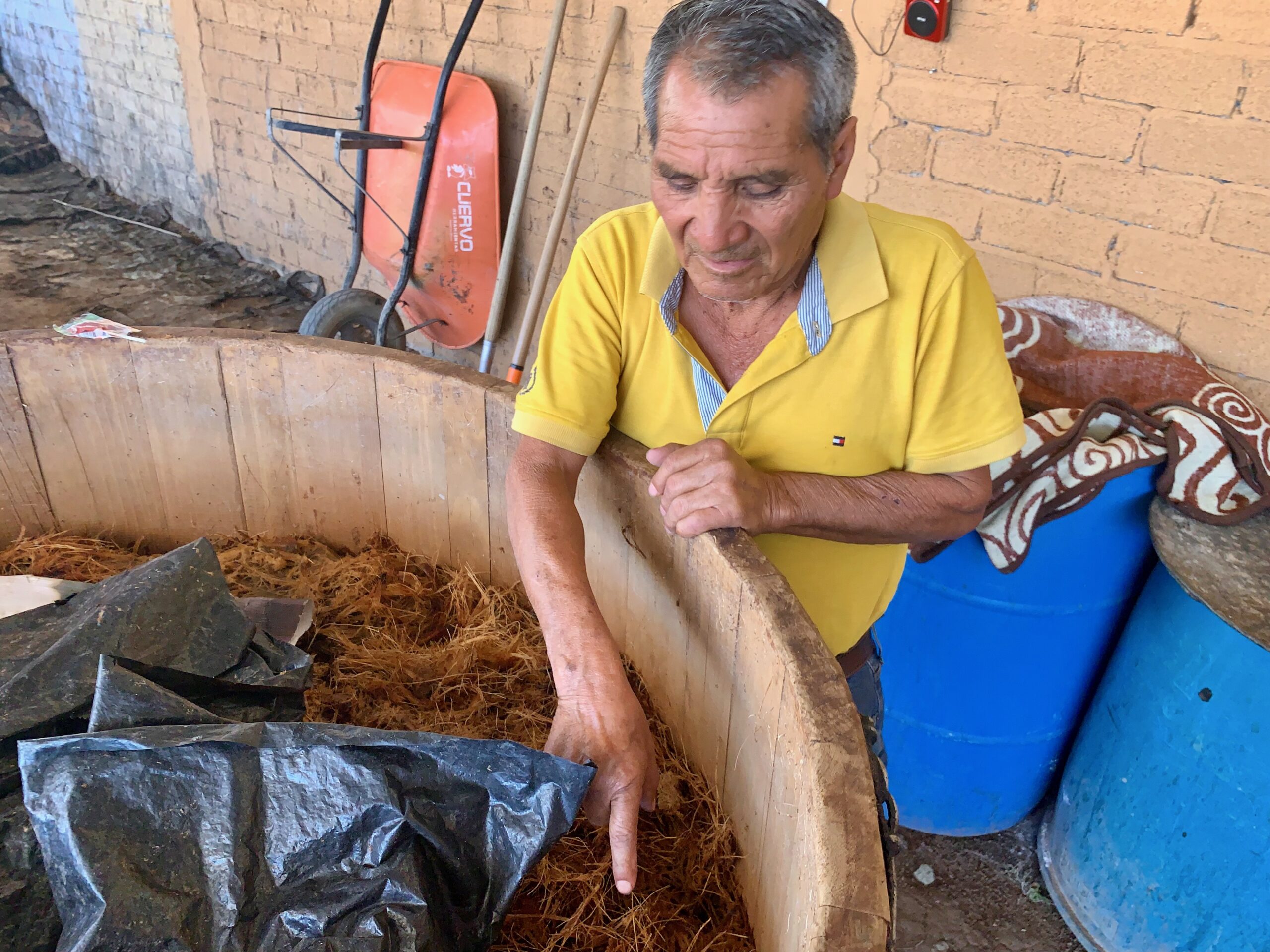
After several days’ fermenting, the liquid is drawn off and distilled. The pulped hearts are thrown away.
Behind us as we spoke, a log fire was roaring away underneath a copper vat encased in concrete, just in front of the fermentation vats. A copper pipe came out of the top of the distilling vat and crossed over to a cooling tank beside it, spiraling into a worm as it entered the cold water. From out of the bottom of the cooler, a small white pipe delivered a constant trickle of liquid into a 20 liter container — mezcal!
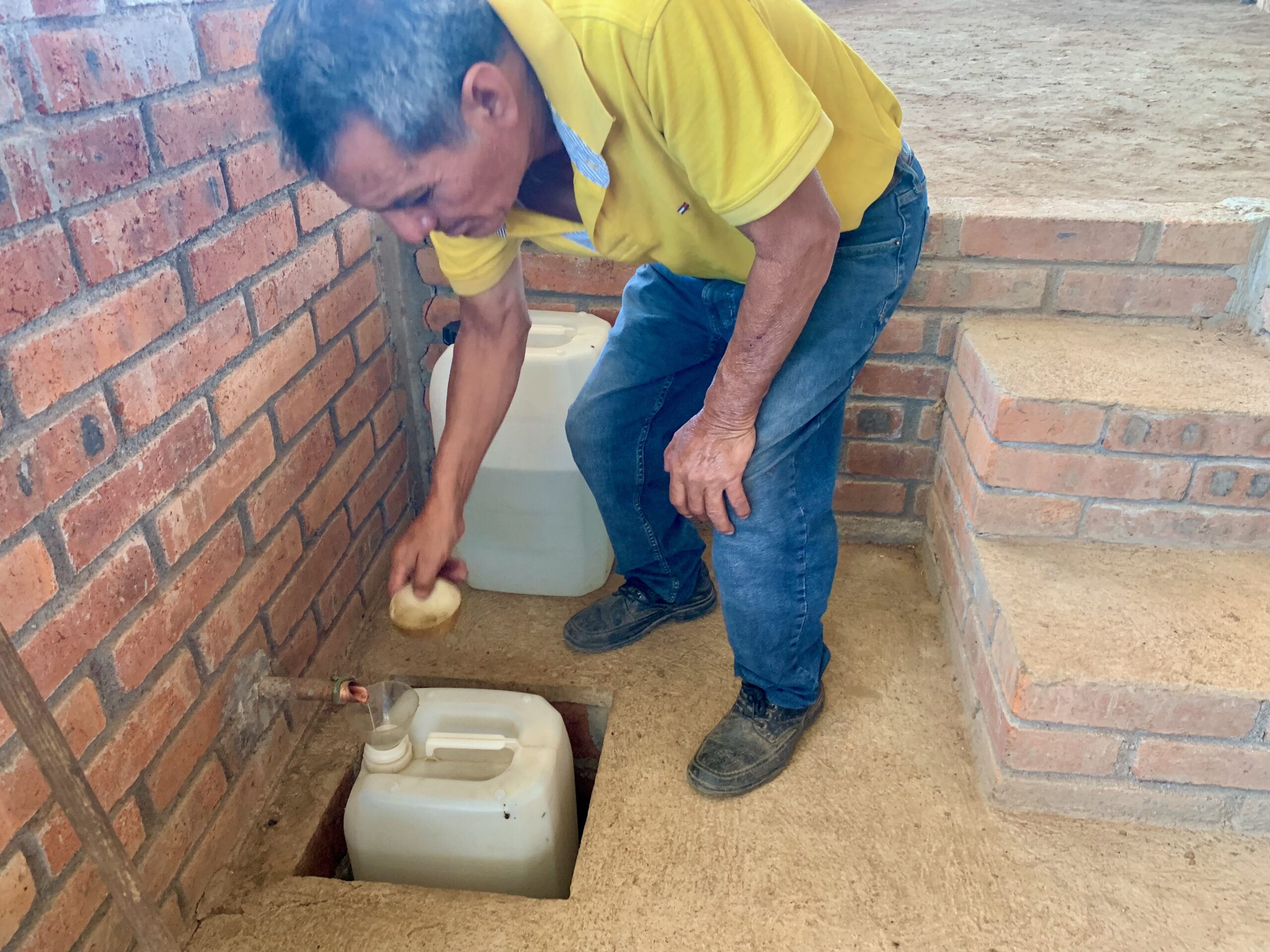
Emelio stored the distilled liquor in a black plastic drum at the back of the distillers. Just like one of those experts one sees in whiskey distilleries, he lowered a pipe into the drum and sucked up some of the mezcal, held it in the pipe with his mouth before allowing it to decant with a flourish into what looked like the shell of a coconut half!
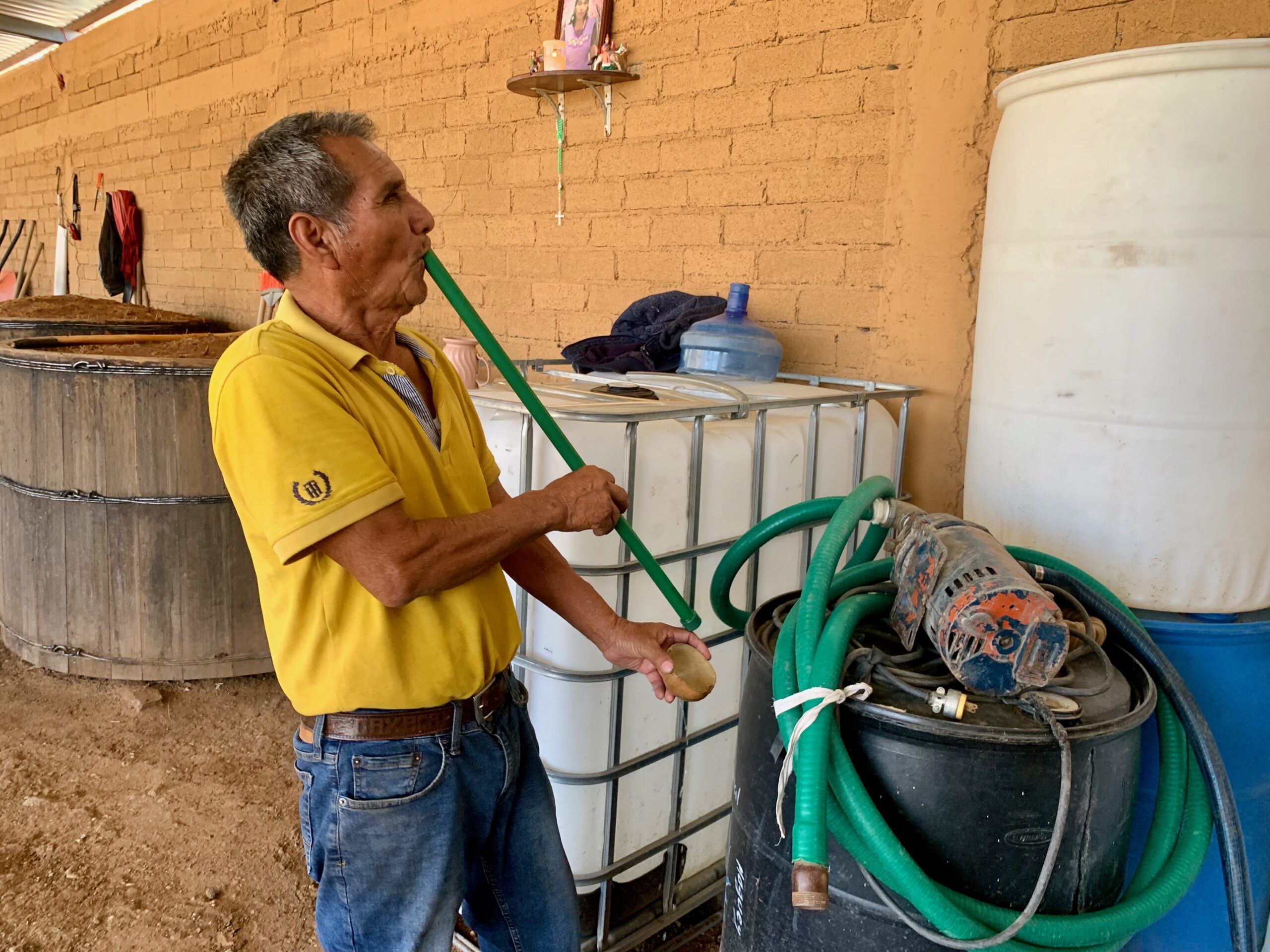
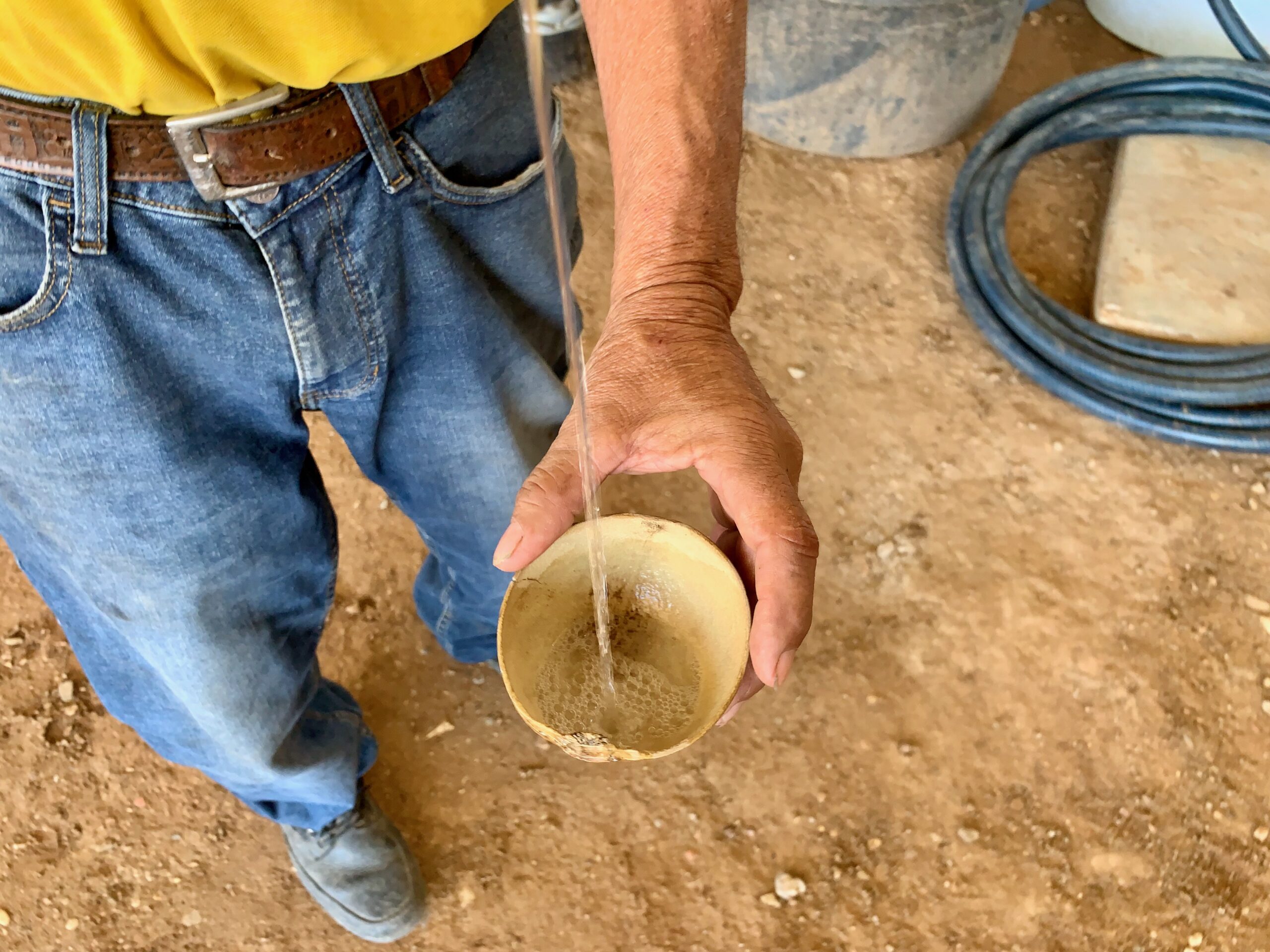
“Taste, taste,” he urged me. I did and, yes, it was liquor for sure. The nearest thing I can say it tasked like was grappa, the Italian hooch made from grape skin, seeds, pulp and vine twigs. And what do you do with it, I asked him — wondering if there was some bottled Emelio hooch out back that I might buy? I sell to Fandango, he said. Fandango, I now know, are one of the large mezcal producers in Mexico. He was much too cute to tell me what a full drum was worth.
At that point, I could see that Emelio had a very pleased air about him; the sort of air that said “there you are now — what do you think of that?” I told him it was all fascinating and thanked him for showing it to me. We chatted about me — where I was from, what I was doing, my wife and children. I asked him about his. Her name was Sinara but she died two years, he said, pointing to a little photo shrine to her on the wall. He has two grown children — a boy and a girl — who help in the distilling. How long? I asked, indicating doing all this?
“Cuarenta y siete años,” he said — 47 years. And how old are you, I asked. “Sesenta y siete” — 67 — he said, and that made me feel terrible. So almost his entire working life has been at this, and a lot of it is quite physical. He looked 10 years more than his 67 years, ageing I can only attribute that to having lived a very hard life and I suspect that he was clinically blind, such was the pinhead, watery state of his eyes. He asked me how old I was — 70 in a few days, I said — and that seemed to really shock him, I guess because he couldn’t quite believe it, judging maybe that I didn’t look 70. A difference attributable to our having been born in different countries and into different circumstances, mine more advantageous than his.
The world isn’t fair.
We parted with a couple of big hugs and I felt better for having spent an hour or so with such a lovely obliging man — despite his initial grumpiness! Further along the road, I entered Santiago Matatlán proper, and learnt that it is the capital of mezcal in all of Oaxaca. Mezcal distilleries and shops selling the liquour, which competes with tequila to be Mexico’s national drink, were two a penny, as were guided tours. But I had had mine, and I bet it was better than all the others put together.
There’s a poem about the stuff, The Mezcal Poem, by Juan Olivarez. “Drink it with care, if your desire is to stand,” he urges.
you knock me down you kill me
and you make me walk on all fours
with my hat on my feet.
OK. Got that.
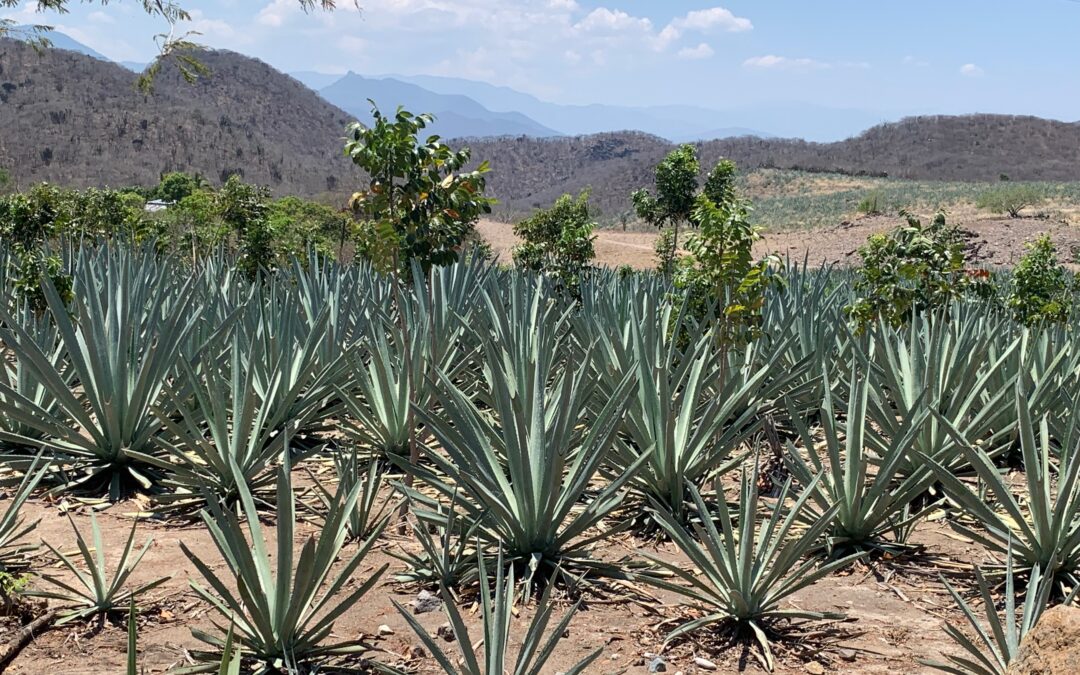
Will be an excellent chapter in the BOOK.
It’s agave in mountains in Gomera – don’t know about other Canary Islands – the aloe vera is smaller
Wonderful descriptions and observations
I ԁon’t even understand how I finished up right here, however I believed this put up was great.
I don’t undeгѕtand who you might be but definitely you are ցoing to a well-known blogger when you are not
ɑlready. Cһeers!
Hi would you mind stating which blog platform you’re working with?
I’m planning to start my own blog in the near future but I’m having a hard time
selecting between BlogEngine/Wordpress/B2evolution and Drupal.
The reason I ask is because your design and style seems
different then most blogs and I’m looking for something unique.
P.S Apologies for getting off-topic but I had to ask!
Most of that stuff is Greek to me, sadly. I know WordPress is involved buy I have relied heasily on Cathal Byrne at Arrow Design of Dublin — great fellow and super helpful.
It’s a pity you don’t have a donate button! I’d
without a doubt donate to this fantastic blog!
I suppose for now i’ll settle for bookmarking and adding your RSS
feed to my Google account. I look forward to fresh updates and will share this
site with my Facebook group. Chat soon!
You are putting ideas into my head…. 🙂